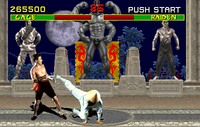Main article: History of video game consoles (fourth generation)
The Mega Drive\Sega Mega Drive\Genesis proved its worth early on after its debut in 1989. Nintendo responded with its own next generation system known as the Super NES in 1991. The TurboGrafx-16 debuted early on alongside the Genesis, but did not achieve a large following in the U.S. due to a limited library of games and excessive distribution restrictions imposed by Hudson.The intense competition of this time was also a period of not entirely truthful marketing. The TurboGrafx-16 was billed as the first 16-bit system but its central processor was an 8-bit HuC6280, with only its HuC6270 graphics processor being a true 16-bit chip. Additionally, the much earlier Mattel Intellivision contained a 16-bit processor. Sega, too, was known to stretch the truth in its marketing approach; they used the term "Blast Processing" to describe the simple fact that their console's CPU ran at a higher clock speed than that of the SNES (7.67 MHz vs 3.58 MHz).
In Japan, the 1987 success of the PC Engine (as the TurboGrafx-16 was known there) against the Famicom and CD drive peripheral allowed it to fend off the Mega Drive (Genesis) in 1988, which never really caught on to the same degree as outside Japan. The PC Engine eventually lost out to the Super Famicom, but, due to its popular CD add-ons, retained enough of a user base to support new games well into the late 1990s.
CD-ROM drives were first seen in this generation, as add-ons for the PC Engine in 1988 and the Mega Drive in 1991. Basic 3D graphics entered the mainstream with flat-shaded polygons enabled by additional processors in game cartridges like Virtua Racing and Star Fox.
SNK's Neo-Geo was the most expensive console by a wide margin when it was released in 1990, and would remain so for years. It was also capable of 2D graphics in a quality level years ahead of other consoles. The reason for this was that it contained the same hardware that was found in SNK's arcade games. This was the first time since the home Pong machines that a true-to-the-arcade experience could be had at home.
This generation ended with the SNES's discontinuation in 1999.

0 komentar:
Post a Comment